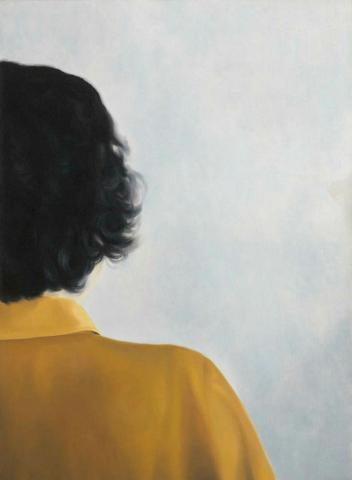Natee Utarit's 'Déjà vu' series
By Reuben Keehan
Artlines | 4-2024 | December 2023
Editor: Stephanie Kennard
Through a generous gift from Richard Koh, the Gallery has recently acquired a series of works by Thai artist Natee Utarit, which significantly enhances the Collection’s holdings of work by the APT alum. Impressed by the cross-cultural resonances of a marble sculpture during a visit to Naples, the artist was prompted to imagine alternative historical encounters between Greco-Roman civilisation and the Buddhist world, writes curator Reuben Keehan.
Natee Utarit has long used Western pictorial languages to question social conventions and political structures in his home of Thailand. He is best known for still-life paintings of an epic scale, imbued with cryptic sub-narratives in keeping with a sophisticated strategy developed by Thai artists in a context where critical commentary can be punishable by law. Other works operate on a more personal level, such as the unconventional triptych Mother 1998, a much-loved work in the QAGOMA Collection, which is currently part of the ‘Asia Pacific Contemporary’ regional tour. First presented as part of the ‘Appearance and Reality’ series in ‘Beyond the Future: The Third Asia Pacific Triennial of Contemporary Art’ (APT3) in 1999, this touching painting portrays three views of the artist’s mother from behind, in an acknowledgment that the private sensibilities of another — even a close family member — may never be fully known.
Natee Utarit’s ‘Déjà vu’ series is a set of ten large, black-and-white woodblock prints, depicting Buddhist narratives and imagery in a classical European style. The idea for ‘Déjà vu’ arose when Utarit began questioning the degree to which Buddhism influences his painterly practice, and how it might interweave with his interest in the legacies of Western colonialism in South-East Asia. This project found visual form when the artist was undertaking a residency in Naples, where he was impressed by the cross-cultural resonances of a marble sculpture during a visit to the Museo Archaelogico Nazionale di Napoli. This prompted him to imagine alternate historical encounters between Greco-Roman civilisation and the Buddhist world, where instead of Alexander the Great conquering Gandhara, the Buddha Gautama wandered all the way to Europe. The resulting prints are a speculative ideation of the artistic works that such an encounter could produce, combining Buddhist iconography with classical and renaissance European aesthetic conventions, while adding droll touches of contemporary culture.
In The Journey 2019, the first work in the series, a Grecian figure with a divine halo poses against Georg Braun and Frans Hogenberg’s iconic 1570 map of Naples, as if Siddhartha himself had visited Campania. Braun’s descriptive text in the ornamental cartouche is replaced with a quotation from Buddha — ‘Dhammam passati, So mam passati’ (‘To see dharma is to see me’) — written in graffiti-style lettering, which Utarit found prevalent in the contemporary Neapolitan cityscape. Such juxtapositions persist throughout the ‘Déjà vu’ series: the devas, those higher beings of the celestial realms, dwell in dramatic Gothic cathedrals; while Buddha chooses to descend from Heaven via an escalator not once but twice. Though decidedly European in composition, these works retain pictorial innovations from thangka painting, most strikingly in renderings of mountains and clouds. Moreover, they are printed as woodblocks on rice paper, processes and materials more properly associated with Asia. These devices further complicate the intersection of cultures in the series.
For Utarit, borrowing images and styles to compose his works is consistent with the structure of his own cultural identity. He notes that while the influence of the West on global art has been far-reaching since the era of high colonialism, South-East Asia has been drawing on cultural beliefs and spiritual practices from China and India since ancient times. ‘On a personal level’, he writes, ‘this has enabled me firm grounding to represent my thoughts in this midst of modern-day confusion, integration and flux.’1 Utarit’s prints, then, are a playful attempt at reconsidering the nature of identity, where borrowing is nothing to be ashamed of.
Reuben Keehan is Curator, Contemporary Asian Art, QAGOMA.
Endnote
- Natee Utarit, artist statement, March 2021.
Connected objects
Related artists
UTARIT, Natee
1970
- present
Full profile
for UTARIT, Natee
Metadata, copyright and sharing information
About this story
- Subject
